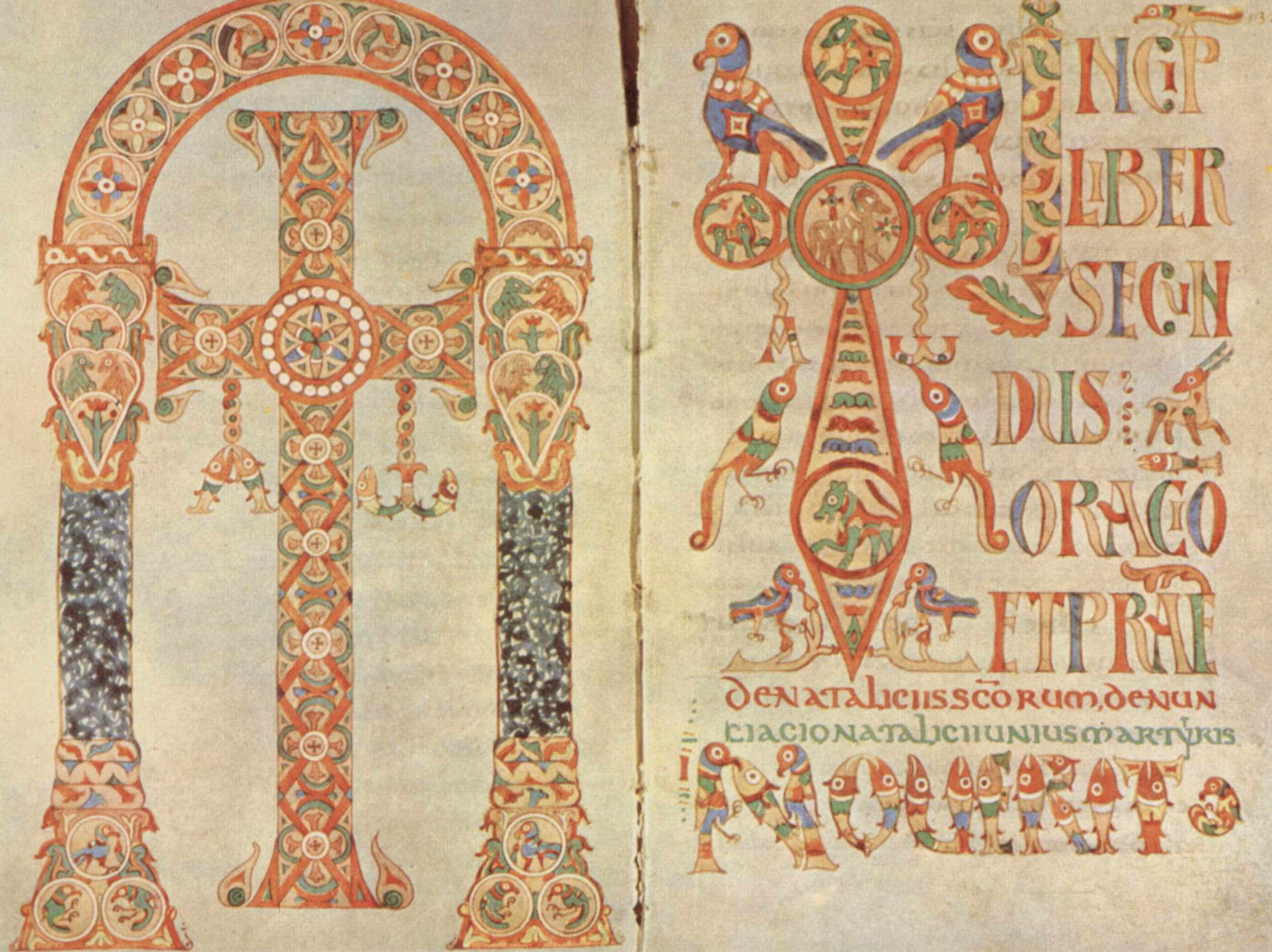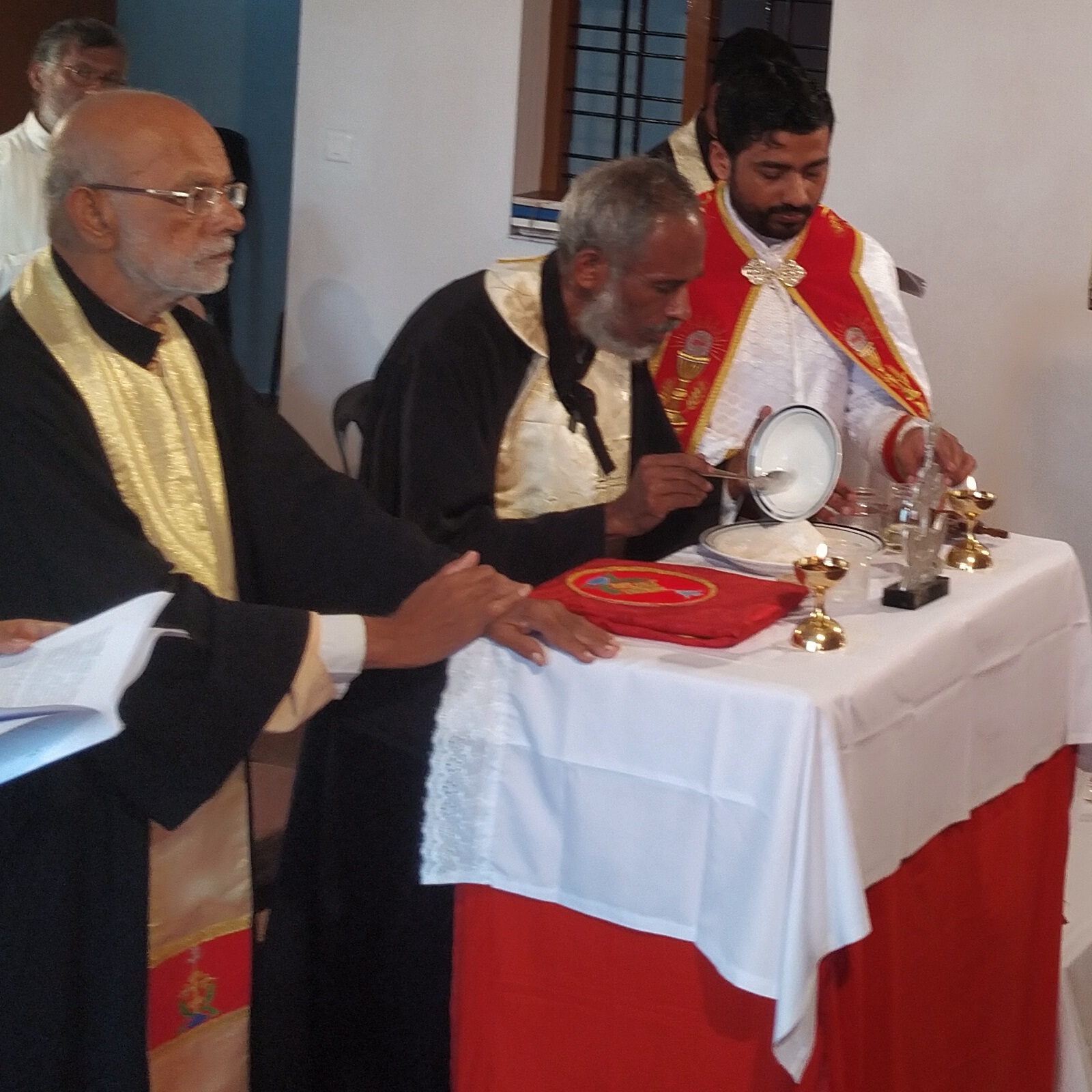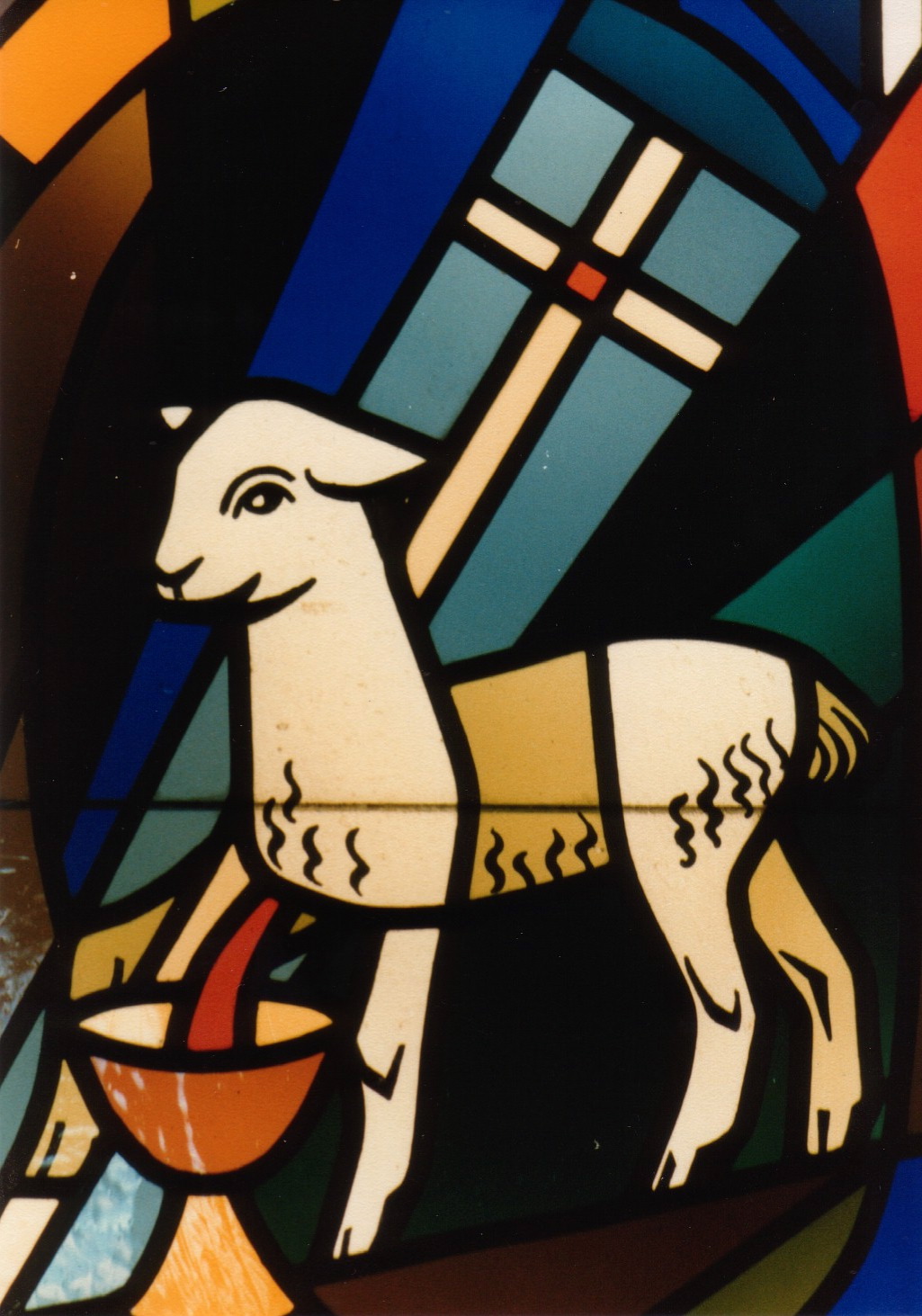|
Lamb (Liturgy)
The Lamb (; ) is the square portion of bread cut from the prosphora in the Liturgy of Preparation at the Divine Liturgy in the Eastern Orthodox Church, Eastern Orthodox and Byzantine Rite, Byzantine Eastern Catholic Churches, Catholic churches. The Lamb is cut from a specially prepared loaf of leavened bread and placed in the center of the paten, diskos. The loaf, called a prosphoron, has had stamped in the top of its dough the seal of the Greek letters Christogram#ICXC, IC, XC, and NIKA, "Jesus Christ conquers", divided by a Greek cross, and the portion by the seal is cutout as the Lamb. The loaf must be made only from the finest flour, yeast, salt and water. It is formed in two layers to symbolize the hypostatic union. Liturgy of preparation The priest cuts the Lamb from the prosphoron using a liturgical knife called a "spear (liturgy), spear", with a blade shaped like a spearpoint to recall the spear used at the crucifixion to pierce Jesus' side. Cutting along each edge, and r ... [...More Info...] [...Related Items...] OR: [Wikipedia] [Google] [Baidu] |
Liturgy St James 2
Liturgy is the customary public ritual of worship performed by a religious group. As a religious phenomenon, liturgy represents a community, communal response to and participation in the sacred through activities reflecting praise, thanksgiving, remembrance, supplication, or repentance. It forms a basis for establishing a relationship with God. Technically speaking, liturgy forms a subset of ritual. The word ''liturgy'', sometimes equated in English as "wikt:service, service", refers to a formal ritual enacted by those who understand themselves to be participating in an action with the divine. Etymology The word ''liturgy'' (), derived from the technical term in ancient Greek (), Liturgy (ancient Greece), ''leitourgia'', which means "work or service for the people" is a literal translation of the two affixes λήϊτος, "leitos", derived from the Attic Greek, Attic form of λαός ("people, public"), and ἔργον, "ergon", meaning "work, service". In origin, it signified ... [...More Info...] [...Related Items...] OR: [Wikipedia] [Google] [Baidu] |
Anaphora (liturgy)
The Anaphora (), Eucharistic Prayer, or Great Thanksgiving, is a portion of the Christian liturgy of the Eucharist in which, through a prayer of thanksgiving, the elements of bread and wine are consecrated. The prevalent historical Roman Rite form is called the " Canon of the Mass". "Anaphora" is a Greek word () meaning a "carrying up", thus an "offering" (hence its use in reference to the offering of sacrifice to God). (This sense is distinct from the usage of "anaphora" in rhetoric and linguistics to mean a "carrying back".) In the sacrificial language of the Greek version of the Hebrew Bible known as the Septuagint, (prospherein) is used of the offerer's bringing the victim ''to'' the altar, and (anapherein) is used of the priest's offering ''up'' the selected portion upon the altar (see, for instance, , , , ). Elements To describe the structure of the Anaphoras as it became standardized from the 4th century, we can look at the structure of the anaphoras in the Antiochene ... [...More Info...] [...Related Items...] OR: [Wikipedia] [Google] [Baidu] |
Prosphora
A prosphora (, ''offering'', or in Demotic Greek πρόσφορον) is a small loaf of leavened bread used in Orthodox Christian, Eastern Lutheran and Greek Catholic (Byzantine) liturgies. The classical plural form is ''prosphorai'' (). The term originally meant any offering made to a temple, but in Orthodox Christianity, as well as Byzantine Rite Lutheranism and Catholicism it has come to mean specifically the bread offered at the Eucharist during Divine Liturgy. Baking A prosphoron is made from only four ingredients, wheat flour (white), yeast, salt, and water. Salt was not used in early times and is still not used in the Greek Orthodox Church of Jerusalem. Any member of the church who is in good standing, has sufficient baking knowledge, and whose conscience is clean may bake prosphora. Often in a parish church the women will take turns baking the prosphora; in monastery, monasteries, the task is often assigned by the Hegumen (abbot or abbess) to one or several mon ... [...More Info...] [...Related Items...] OR: [Wikipedia] [Google] [Baidu] |
Sacramental Bread
Sacramental bread, also called Communion bread, Communion wafer, Sacred host, Eucharistic bread, the Lamb or simply the host (), is the bread used in the Christian ritual of the Eucharist. Along with sacramental wine, it is one of two elements of the Eucharist. The bread may be either leavened or unleavened, depending on tradition. Catholic theology generally teaches that at the Words of Institution the bread's substance is changed into the Body of Christ, a process known as transubstantiation. Conversly, Eastern Christian theology generally views the epiclesis as the point at which the change occurs. Christianity Etymology of ''host'' The word ''host'' is derived from the Latin , which means 'sacrificial victim'. The term can be used to describe the bread both before and after consecration, although it is more correct to use it after consecration. Eastern traditions With the exception of Churches of the Armenian Rite, the Maronite Church, and the Syro-Malabar Church, ... [...More Info...] [...Related Items...] OR: [Wikipedia] [Google] [Baidu] |
Lamb Of God
Lamb of God (; , ) is a Names and titles of Jesus in the New Testament, title for Jesus that appears in the Gospel of John. It appears at wikisource:Bible (American Standard)/John#1:29, John 1:29, where John the Baptist sees Jesus and exclaims, "Behold the Lamb of God who Salvation in Christianity, takes away the Sin#Christianity, sin of the world." It appears again in wikisource:Bible (American Standard)/John#1:36, John 1:36. Christian doctrine holds that a God the Son, divine Jesus chose to suffer crucifixion of Jesus, crucifixion at Calvary to save the world from its sins. He was given up by God the Father, divine Father, as an "agent and servant of God in Christianity, God" in carrying away the sins of the world. In Christian theology the ''Lamb of God'' is viewed as both foundational and integral to the message of Christianity. A lion-like lamb that rises to deliver victory after being slain appears several times in the Book of Revelation. It is also referred to in Pauline w ... [...More Info...] [...Related Items...] OR: [Wikipedia] [Google] [Baidu] |
Body Of Christ
In Christian theology, the term Body of Christ () has two main but separate meanings: it may refer to Jesus Christ's words over the bread at the celebration of the Jewish feast of Passover that "This is my body" in (see Last Supper), or it may refer to all individuals who are "in Christ" (; see Christian Church). As used by Paul in the Pauline epistles "Body of Christ" refers to all individuals who "heard the word of truth, the gospel of your salvation, believed in him, were sealed with the promised Holy Spirit" (), "are being built together into a dwelling place for God by the Spirit" (), are "joined and held together by every joint with which it is equipped, when each part is working properly, makes the body grow so that it builds itself up in love" (). There are significant differences in how Christians understand the term as used by Christ at the Last Supper and as developed in Christian theology of the Eucharist. For some it may be symbolic, for others it becomes ... [...More Info...] [...Related Items...] OR: [Wikipedia] [Google] [Baidu] |
Liturgy Of The Presanctified Gifts
The Liturgy of the Presanctified Gifts (Greek: λειτουργία τών Προηγιασμένων Δώρων) also referred to as ''The Divine Liturgy of Saint Gregory the Dialogist'' is a Byzantine Rite liturgical service which is performed on the weekdays of Great Lent and the first three days of Holy Week wherein communion is received from Gifts (the Body and Blood of Christ) that are sanctified (consecrated) in advance, hence its name; this Divine Liturgy has no anaphora (Eucharistic Prayer). The Presanctified is used on the weekdays of Great Lent, a season of repentance, fasting, and intensified prayer when the more frequent reception of communion is desirable; however, the full Divine Liturgy having a joyful character is not in keeping with the somberness of the season of repentance (''Eucharist'' literally means 'thanksgiving') and so the Presanctified is substituted. Although this service may be performed on any weekday (Monday through Friday) of Great Lent, common ... [...More Info...] [...Related Items...] OR: [Wikipedia] [Google] [Baidu] |
Holy Week
Holy Week () commemorates the seven days leading up to Easter. It begins with the commemoration of Triumphal entry into Jerusalem, Christ's triumphal entry into Jerusalem on Palm Sunday, marks the betrayal of Jesus on Spy Wednesday (Holy Wednesday), climaxing with the commemoration of the Last Supper on Maundy Thursday (Holy Thursday) and the Passion of Jesus on Good Friday (Holy Friday). Holy Week concludes with Christ's Crucifixion of Jesus, death and Harrowing of Hell, descent into hell on Holy Saturday. For all Christian traditions, it is a Moveable feast, moveable observance. In Eastern Christianity, which also calls it Great Week, it is the week following Great Lent and Lazarus Saturday, starting on the evening of Palm Sunday and concluding on the evening of Holy Saturday, Great Saturday. In Western Christianity, Holy Week is the sixth and last week of Lent, beginning with Palm Sunday and concluding on Holy Saturday. Christians believe that Jesus rested in death from the n ... [...More Info...] [...Related Items...] OR: [Wikipedia] [Google] [Baidu] |
Great Lent
Great Lent, or the Great Fast (Greek language, Greek: Μεγάλη Τεσσαρακοστή, ''Megali Tessarakosti'' or Μεγάλη Νηστεία, ''Megali Nisteia'', meaning "Great 40 Days", and "Great Fast", respectively), is the most important fasting season of the church year within many denominations of Eastern Christianity. It is intended to prepare Christians for the greatest feast of the church year, Easter, Pascha (Easter). Great Lent shares its origins with the Lent, Lent of Western Christianity and has many similarities with it. There are some differences in the timing of Lent, besides calculating the date of Easter and how it is practiced, both liturgically in the public worship of the church and individually. One difference between Eastern Christianity and Western Christianity is the calculation of the date of Easter (see Computus). Most years, the Eastern Pascha falls after the Western Easter, and it may be as much as five weeks later; occasionally, the two dat ... [...More Info...] [...Related Items...] OR: [Wikipedia] [Google] [Baidu] |
Consecration
Sacred describes something that is dedicated or set apart for the service or worship of a deity; is considered worthy of spiritual respect or devotion; or inspires awe or reverence among believers. The property is often ascribed to objects (a " sacred artifact" that is venerated and blessed), or places (" sacred ground"). French sociologist Émile Durkheim considered the dichotomy between the sacred and the profane to be the central characteristic of religion: "religion is a unified system of beliefs and practices relative to ''sacred things'', that is to say, things set apart and forbidden." Durkheim, Émile. 1915. '' The Elementary Forms of the Religious Life''. London: George Allen & Unwin. . In Durkheim's theory, the sacred represents the interests of the group, especially unity, which are embodied in sacred group symbols, or using team work to help get out of trouble. The profane, on the other hand, involve mundane individual concerns. Etymology The word ''sacred' ... [...More Info...] [...Related Items...] OR: [Wikipedia] [Google] [Baidu] |
Altar
An altar is a table or platform for the presentation of religion, religious offerings, for sacrifices, or for other ritualistic purposes. Altars are found at shrines, temples, Church (building), churches, and other places of worship. They are used particularly in Christianity, Buddhism, Hinduism, and modern paganism. Many historical-medieval faiths also made use of them, including the Religion in ancient Rome, Roman, Religion in ancient Greece, Greek, and Norse paganism, Norse religions. Etymology The modern English language, English word ''wikt:altar#English, altar'' was derived from Middle English ''wikt:alter#Latin, altar'', from Old English ''wikt:alter, alter'', taken from Latin ''wikt:altare#Latin, altare'' ("altar"), probably related to ''wikt:adolere#Etymology 2, adolere'' ("burn"); thus "burning place", influenced by ''wikt:altus#Latin, altus'' ("high"). It displaced the native Old English word ''wikt:weofod#Old English, wēofod''. Altars in antiquity In antiquity, alta ... [...More Info...] [...Related Items...] OR: [Wikipedia] [Google] [Baidu] |









